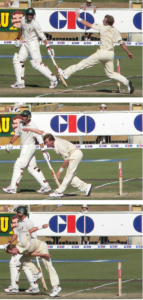When discussing the physical nature of bowling and the training preparation for it, we are almost exclusively referring to pace bowling, rather than spin bowling. Pace bowling is much more physically demanding, players have far greater instances and severity of injuries, a shorter career spans, dure to this reality. As a result, strength training contributes greatly to the level of performance as well as injury reduction for pace bowlers. For spin bowling, mobility and general strength is still good to have, but it will contribute more so to when batting than to the actual spin bowling per se.
Shoulders
While the throwing action and bowling action are quite different, and the physical demands or positions that the arm and shoulder are placed in are different, the discussion that we had about how we target training the shoulder for throwing all applies here too. A combination of external rotator strength and scapula stability forms the general approach to what will contribute to shoulder health and performance within bowlers.
Rotation
Just as with throwing, bowling involves the need for effective and powerful rotation ability. Just like throwing, it will look different, however the underlying requirement is still the same, effective, powerful, full range of motion rotation on both sides, across different lines of movement. This forms the reasoning for our woodchop versions, as well as medicine ball rotation work.
Lower Back
The lower back is the most common injury site for pace bowlers. Lower back pain in fast bowling has mainly been attributed to technical issues associated with a “mixed” bowling action. The mixed action is characterized by the fast bowler having a more front-on hip orientation and a more side-on shoulder orientation, or vice versa, at back foot impact. In other words, most injury tends to result from technical issues.
While technical issues in bowling are beyond the scope of this article, what we do know is that developing a greater level of strength in the key surrounding areas will provide for a greater buffer against potential injury. These key areas are the core and hips (discussed in the last section about throwing) as well as legs. The better your lower body strength levels, and the better your core stability and hip strength and stability are, the better you will be able to cope with the forces and the potential injury from a poor technique as a result.
Naturally improvements in bowling technique will also be helpful. It isn’t a case of doing one or the other. But from a strength point of view, this highlights again the utility of other principles we have covered so far (single leg strength, hip stability, core work, neuromuscular reserve, training standing up, etc).

Load acceptance (landing) and delivery
There are roughly 6 x a players bodyweight going through the front leg and hip upon the final step of a fast bowling delivery. This is the most powerful expression of the eccentric strength and power in cricket that a player requires, that we touched upon earlier in this section. Remember that eccentric strength and eccentric power represent the abilities to control the downward part of a high force and a high speed. So for example, when you land from a jump, you require eccentric strength, and the faster you are required to control this landing, the more eccentric power is required.
Poor eccentric strength, power and landing ability is a common contributor in ACL knee injuries in athletes (particularly female) in other sports like football codes. While ACL injuries aren’t a common injury at all in cricket, ankle sprains certainly are, while hamstring strains are not uncommon. While the lower back is an area of concern for fast bowlers as already covered. All these areas can be minimized by targeted eccentric strength and eccentric power training.
The single leg nature of this landing in bowling, as well as the bending from the hip, plus the torso rotation element (a very awkward action when really analyzed), make this a more complex movement than normal landing from a jump. That is why we must combine the different movements (deadlifts, cable rotations, medicine ball rotations, single leg deadlifts, etc) with the high powered plyometric work (double leg landings, single leg landings, depth drop, depth drop + jump, etc) to build a comprehensive and efficient training program to develop this load acceptance in pace bowling.
Acceleration
Particularly important for pace bowlers is acceleration. After all, it is the powerful acceleration, running speed, and speed upon delivery, that is going to help impart velocity on the ball when bowling.
It is well established that concentric strength developed in exercises such as squats, step ups and lunge variations is a contributor to acceleration ability. While isometric strength is a key component to the force generated when sprinting at maximal speed.
The specific strength exercises on their own are valuable. However, the best way to truly carryover to development in acceleration is to actually train acceleration over those distances that you perform your bowling run up. So it is important to remember that a combination of the 2 is essential. But being a site on strength and power training, we focus on the strength element. We must never forget that cricket is a game largely based on skill (batting, bowling, throwing and catching). The physical abilities merely provide a platform for us to do these things better.
Ankle Injury
As mentioned, ankle injuries are fairly common in cricket, especially for pace bowlers. What we aim to do is limit all the intrinsic risk factors, which lead to an even greater chance of ankle sprain – things such as poor landing mechanics, low eccentric strength levels especially in a single-leg stance, inadequate levels of eccentric power, inadequate change of direction and control, inadequate core strength and hip stability. Or in other words as we worded it before, we can condition to create a buffer of physical capacity or ability that makes the body more resilient to these occurring.
So by working to strengthen specifically targeting certain areas, we are building a structure that will have greater control and greater strength, and as a result, be more resistant to the external risk factors associated with cricket.
“Appropriately conditioned players are more resistant to the neuromuscular fatigue that renders athletes susceptible to injury.”
“In view of the fact that the majority of ankle injuries occur when landing or changing direction, appropriate movement skills instruction and training is also identified as a means of reducing injuries.”
Paul Gamble
This further highlights why we are performing single leg strength and stability exercises, core exercises and the all-important plyometric exercises that we are in our programming. The ankle is yet another area that will benefit as a result of work being done higher up the chain (at the mid-section and hips.) Remember, everything is connected – there is no isolation.
